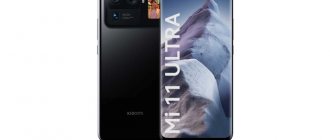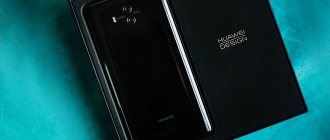We received the Honor 20 smartphone for review, which, let us remind you, differs from the Pro version only in other photo capabilities, slightly smaller ROM and RAM, and a less interesting color scheme of the back cover.
Those who can’t bear to wait for news about the release of Honor 20 Pro in Russia can take a closer look at the younger model, as it has the same Kirin 980 processor, NFC chip, identical display and speakers.
We got acquainted with the Honor 20 family a week before the official announcement in London, which took place the day after the introduction of sanctions against Huawei in the United States. However, about two weeks ago, Huawei/Honor kindly sent us their junior model Honor 20 so that we could share with you our opinion about this device.
Equipment and ergonomics
The smartphone comes in a white box with reflective gray round patches on the front side, on which the gadget itself is depicted on the back and front, and on the ends of the box there is the name and brief information about the characteristics of the device.
The package includes:
- Honor 20;
- Huawei SuperCharge power adapter (same as Huawei P30);
- USB to USB type-C cable;
- Tool for removing the nano-SIM slot;
- A set of standard waste paper and a warranty card.
The smartphone does not have a 3.5 mm Jack, so on the bottom edge there is only a USB-type C connector, the main speaker and a microphone. On the left side we only have a slot for two nano-SIM cards, on the top side there is an infrared port. On the right side, in addition to the volume rocker, there is a power button with a built-in fingerprint scanner.
On the back panel there are 4 camera modules and a flash. The front of the smartphone houses a 6.26-inch screen, standard sensors with an earpiece and a front camera lens tucked into the top left corner.
In all other respects, the smartphone has a standard candy bar form factor, except that the power button, due to its feature, does not stick out, but rather is slightly recessed into the body. One main mono speaker, as I mentioned above, is located at the bottom, so when playing or watching a video, you will have to choose a grip so as not to block the sound source with your fingers.
The device lies comfortably in the palm of your hand; there is a one-handed control mode called up with a diagonal gesture from the bottom corner (the angle depends on which hand you control). Gesture controls are almost identical to EMUI, despite a different shell - all new Honor smartphones run on Magic UI out of the box. By the way, Huawei has already promised that it will release an update to Android Q for Honor 20 Lite, Honor 20 and Honor 20 Pro in the future.
You can also standardly select the so-called “Navigation System” here, which specifies options for interacting with the operating system:
- Gestures standard for all Android smartphones;
- Even more standard for Android are three function buttons (back, home, running applications);
- And something new: “Navigation button” is the quintessence of the first two options. And although I didn’t have much time to master it, it seems like we see the point in this - the button is capable of working in both types of interaction and is located wherever your heart desires.
Xiaomi Mi A2
Xiaomi Mi A2 is inexpensive. The smartphone is housed in a durable metal case and has very decent cameras for a budget phone. The battery is also not the worst - 3000 mAh. The fingerprint scanner is located on the back.
It is far from flagship characteristics, but to the delight of pure Android lovers, it is included in the Android One program. Mi A2 comes with a minimum of two years of OS updates and three years of security updates. The smartphone launched with Android 8.1 Oreo on board; after purchase, you can immediately upgrade to Android 9.0 Pie.
Display
The IPS display occupies 91.6% of the front of the smartphone, has a resolution of 2340x1080 pixels, 16.7M colors and 412 ppi. The display here is not OLED, but the image quality is excellent - the picture is pleasing to the eye.
The screen does not cause any inconvenience - it is easy to use, there are no phantom touches or random activations. There are no complaints about viewing angles, it’s just that the picture becomes darker, since the diodes are not aimed directly at your eyes.
Color rendition is good and “rich”, and presets and color temperature can be adjusted to taste.
Meizu M6s
An inexpensive smartphone from Meizu was released at the very beginning of 2022, but is still an interesting option for those who want to buy something modern with decent parameters and an adequate price. First of all, it should be noted that the M6s has an all-metal body, which is not common in 2022. This is the company's first model without the traditional physical mTouch button - it has become a touch button with completely similar functionality. The finger scanner was moved to the side edge. They did not combine it with the power key - the fingerprint sensor is located separately and can be easily felt with a finger without even looking. Users reacted positively to this location.
The device cannot boast of a dual camera or an NFC chip, however, the manufacturer has equipped it with a modern 18:9 screen, mCharge fast charging, a powerful chipset from Samsung and memory modifications that are quite adequate for the price - 3/32 GB and 3/64 GB. Another important fact is that due to the elongated display, the model received a 5.2-inch phone body, that is, the smartphone is very compact, which will appeal to many buyers who do not want to carry a huge “shovel”, of which the vast majority are on the modern market.
Performance
What I like about the policy of the Honor brand and its parent company Huawei is the installation of the top-end Kirin 980 processor, regardless of the price segment of the smartphone, starting with the P30 family (which, let me remind you, is 50 and 70 thousand rubles) right up to our Honor 20.
Therefore, due to the fact that in our current model the amount of RAM is less than in the Pro version, the performance and operability of the device is excellent in “any weather” (summer is here, so I can’t check it in winter, it’s a shame).
Speaking of memory, Honor didn’t bother and made only one variant each for the Russian market: Honor 20 and Honor 20 Pro. Therefore, in our case it is 128 GB of permanent storage and 6 GB of RAM (the Pro version, which is hiding from us, has 256 and 8 GB, respectively). This is enough for gaming, working with documents, boarding surfing and watching videos.
Speaking of games: when launching PUBG, the game immediately selected a preset with high (that is, at the moment, maximum) graphics settings and the smartphone, without any hesitation, “eats” this action game with explosions, crowds of enemies from all sides and moving vehicles.
In AnTuTu, the smartphone in “Power Saving Mode”, which is enabled by default, scored not so many, but well-deserved 214,590 points, overtaking the brothers Huawei P20 and Honor Play and taking its honorable 27th place in the ranking. But in “Productive mode” the device immediately scored 313,334 points – that is, Honor 20 is in the TOP 10 most powerful Android smartphones.
True, in maximum performance mode, the battery life of Honor 20 is significantly reduced - more than twice. In addition, in this mode the device heats up quite well.
The software here covers Android 9 with the proprietary Magic UI 2.1.0 shell, which is not far removed from EMUI 9 - even the same long-suffering knuckle gestures were brought up, but here they seem to work even more adequately, which is good.
Huawei Mate 20 Pro
The Mate 20 Pro is rightfully considered the best among Huawei flagships. In addition to the IR port, the smartphone is equipped with a curved screen, a display fingerprint sensor and a huge battery. The latest member of the Mate series features a stunning design, a triple camera and 3D facial recognition.
It has everything that a modern user might need, including IP68 dust/moisture protection. The Mate 20 Pro has a reverse charging feature and can act as a wireless charger for other gadgets. But like the P20 Pro, it doesn't have an audio jack. The smartphone is controlled by the proprietary Huawei EMUI shell. It may not be the most convenient or beautiful, but there won’t be any problems with customization: an android is an android, configure it as you want.
The Mate 20 Pro is an expensive proposition. At the start of sales in October last year, its price was 77 thousand rubles. Since then, it has decreased, but unfortunately not so much that Huawei’s main flagship has become available to everyone.
Camera
As mentioned above, the smartphone has 4 main camera modules:
- 48 MP (Sony IMX586), with f/1.8 aperture and AI image stabilization (AIS);
- 16 megapixel “super wide-angle” module with f/2.2 aperture and a shooting angle of 117 degrees;
- 2 MP module with support for bokeh effect and f/2.4;
- 2 MP macro module also with f/2.4.
By default, the Quad Bayer filter combines four pixels into one, taking a photo at 12 MP resolution:
But in the camera application you can set the mode to “48 MP – Ultra Clarity with AI”. In this case, the photos will be taken in 48 megapixel resolution, and artificial intelligence will stitch several frames into one - you need to wait 2 seconds. It is better to photograph stationary objects and landscapes:
The camera corresponds to its price segment and in most cases takes good pictures, with the possible exception of the 10x zoom, which is not the strongest side of the smartphone. After the same 30x of the P30, here it looks rather weak and the image quality of the magnified object is still not the same as compared to the above-mentioned model:
The front camera has a 32 megapixel module and f/2.0 aperture. She is good and if you don’t turn on the “enhancement” mode (beaty filters that are not loved by men), she takes quite good selfies:
The rear camera is capable of recording video in 4K and supports electronic stabilization EIS, the front camera is only 1080p also with EIS technology. Examples of video shooting with the main and front cameras in various conditions:
The standard application for taking photos and videos almost completely replicates the interface and functionality of the shell of its Huawei counterparts. The only surprising thing is that by default the buttons are arranged in a strange order, so for some reason, from the “more” tab, the 3D emoji mode moved to the main menu of the camera, and the “Panorama”, “Pro” and “Aperture” modes, on the contrary, were moved to the list of additional functions .
Honor 10
In mid-2022, Honor will release its top-end device, which gets a lot of features from Huawei flagships, but is cheaper. The model has an interesting appearance with new material. It consists of 36 layers, which when the sun's rays fall on it gives 36 different shades. In 2022, this feature is used in most Huawei and Honor phones, and in many other brands, but at the time of its release it looked cool and original. The phone was launched in four colors - black, grey, shimmering green and shimmering blue. However, not only the appearance will please the user.
The device runs on the best Huawei chipset of 2022 – Kirin 970, which is still capable of handling any task today. We are pleased with good memory modifications, a powerful dual camera on the back with Ai support, as well as a high-quality front matrix. The 3400 mAh battery is complemented by Super Charge charging - in 25 minutes you can reach 50% of the capacity. There are all the necessary modern wireless interfaces including NFC and infrared. Music lovers will be pleased with the Asahi Kasei AK4376A DAC, which can significantly improve the sound quality of music. The display is 19:9 with a notch, which can be removed in the settings.
The result is a very interesting smartphone with excellent performance and a very affordable price.
Autonomy and charging speed
The smartphone has a battery with a capacity of 3750 mAh and charges up to 50% in just 30 minutes (if you use 22 Watt charging from Honor, of course), my smartphone charged up to a hundred in just over 1 hour, the company seems to know a lot about saving battery and does not tend to burn it out in the first month, and the smartphone itself holds up quite calmly and in 7 hours of active testing of the camera and video on YouTube dropped from ~90% to 55% - I consider this result worthy.
I'm glad that a fast charger is included in the package. Support for wireless charging was not announced by the manufacturer.
Redmi 7
The second smartphone released by the newly created Redmi brand promises to become the most interesting gadget among inexpensive devices in 2019. The model has a modern 19:9 display with a drop-shaped cutout for the front camera and Gorilla Glass 5, the body has a water-repellent coating according to the P2i standard. The new product runs on the latest eight-core Snapdragon 632 chipset, the maximum frequency reaches 1.8 GHz. The main camera is dual with AI support (a similar one was in the Xiaomi flagship - Mi 6).
Buyers will be pleased with a large selection of memory modifications, a dedicated slot for memory expansion (for those who choose the 2/16 GB version, this is especially relevant), a capacious battery and fingerprint protection. The device has a beautiful appearance in three colors - red, blue and black. Traditionally, the brand did not support NFC in the smartphone, but all other wireless interfaces, including the IR port, are present. Out of the box, the device runs on Android 9.0 Pie with MIUI 10 firmware. The phone is not widely represented in Russian retail and has a fairly high price tag, so it’s more logical to take a closer look at buying it on Aliexpress.
Sound, NFC and more
The sound quality here is decent, however, with headphones during the video shooting test, my voice seemed a little robotic to me. In any case, the audio system supports the operation of acoustic accessories in Virtual 9.1 surround sound and Huawei Histen 6.0 mode, and when recording audio, noise reduction is provided by two microphones on top next to the IR port and the main microphone at the bottom.
In terms of sensors and modules, everything is standard: Bluetooth 5.0, LTE and VoLTE, W-iFi 802.11ac, NFC, standard satellite navigation systems, Hall sensor, gyroscope, compass, etc. according to the list.
We should also highlight the fingerprint sensor. It is physical and its speed corresponds to the manufacturer’s assurance - unlocking is carried out in just 0.5 seconds. Perhaps, so far this is the only fingerprint scanner that I could like more than TouchID 2-Gen in my iPhone 7.
The NFC sensor, of course, allows you to make payments through the Google Pay service, just don’t forget to download it from Google Play first (sorry for the pun). But G Pay is the only service that you can choose for payment at the moment. What the manufacturer plans to do if the United States cuts off the company’s “oxygen” to this service is an interesting question, but at the same time sad and alarming.
Why doesn't the IR port work on Honor and Huawei?
Sometimes the described service experiences unexpected failures and stops working. In such cases, users should think about the reasons for what happened and try to eliminate them. As a result, everything will be restored automatically and smartphone owners will again be able to control household appliances and use convenient functions.
If you have any questions or complaints, please let us know
Ask a Question
Causes
The main causes of problems are usually on the surface:
- phone malfunction;
- incorrect settings of the sensor and remote control buttons;
- interference that prevents communication with electronics;
- lack of the required application or the need to update the program and device software.
Other sources of problems are much less common and are usually associated with serious breakdowns of smartphones.
IR transmitter in smartphones: more alive than all living things
It often happens that fashion for certain hardware features in smartphones quickly comes and goes. Examples of this are 3D displays and xenon flashes. Some will think that such functions include IR transmitters. Yes, IR transmitters in smartphones are not currently advertised. But this only means that they have become, although rare, quite common components. In this article we will talk about new smartphones with IR transmitters, and also pay attention to applications and third-party accessories for remote control of equipment.











